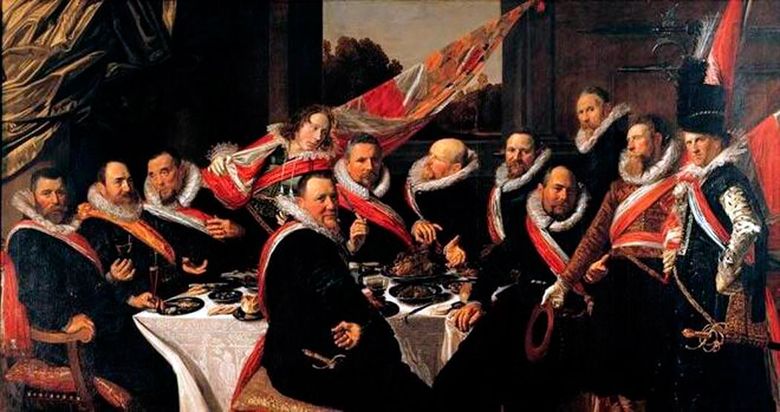
“Banquet of officers of the company of St. George” – was written in 1616, when the artist was about thirty years old. This huge canvas – the first monumental work of Dutch painting of the XVII century. Just a few years before that, a truce with the Spaniards was concluded, the de facto independence of the country was recognized. The era of the heroic struggle has not yet moved to the past, the Harlem arrows – yesterday’s participants in this struggle. In their self-invocation, there is a touch of clever, good-natured humor, they are full of persevering self-assertion, but they do not oppose themselves to the viewer, as is usually the case in the ceremonial portraits of that time. They address themselves kindly and at ease to the viewer, as if ready to receive him into their company.
Here there is a comradely corporate spirit. The unity of the general mood is combined with the vivid expressiveness of individual portraits: there is full of self-respect Colonel van Berkeirod, and mocking fat captain van der Meer, and a smart dandy, the standard-bearer van Offenberg, standing at the right edge of the picture. In 1612-1615 Khals himself served in this company and knew them all well. The composition seems simple, but in reality it is dominated by a carefully thought out order. As in separate figures and faces, and in their grouping and in the depiction of space, Hals achieved a special vitality, a naturalness that will become an integral feature of the art of the 17th century.
In contrast to a rather dark overall color, diagonals of motley banners stand out, red and white scarves, officers tied over the shoulder, a white linen tablecloth and a beautifully painted still life on the table. Dense painting conveys materiality, the weight of objects, their completed stable form. However, already here and in the poses of figures and a free smear in places appears that unconstrained mobility, which will subsequently be so characteristic of the entire work of Hals.
 Banquet of officers of the company of St. Adriana by France Huls
Banquet of officers of the company of St. Adriana by France Huls Group portrait by France Huls
Group portrait by France Huls Arrows of the guild of St. Adriana by France Huls
Arrows of the guild of St. Adriana by France Huls Singing Boys by France Huls
Singing Boys by France Huls Officiers de banquet de la compagnie de St. George – Frans Hals
Officiers de banquet de la compagnie de St. George – Frans Hals Gypsy girl by France Huls
Gypsy girl by France Huls Portrait of Jasper Schade van Vestrum by France Huls
Portrait of Jasper Schade van Vestrum by France Huls Lady with a Fan by France Huls
Lady with a Fan by France Huls